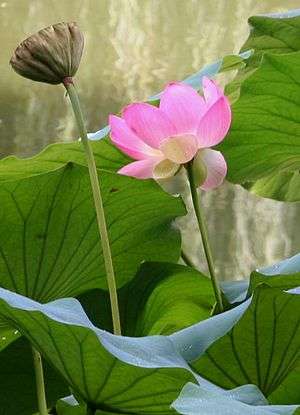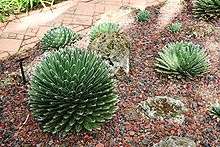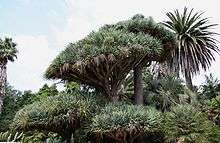Lotusland

The place-name Ganna Walska Lotusland, also known as the (15 ha / 37 acres) Lotusland, is the historic estate of Madame Ganna Walska and current location of a non-profit botanical garden in uniquely designed landscape gardens located in Montecito, near Santa Barbara, California, United States. The Lotusland botanic garden is open to the public by advance reservation only, with walking tours 1½ to 2 hours long through the distinctive gardens. The gardens are open to the public Wednesday through Saturday for the 9-month period from February 15 to November 15. There are two tours a day, the first at 10:00 am and the second at 1:30 pm. The County of Santa Barbara restricts visitation via a conditional use permit and reservations are required.
History
Ralph Kinton Stevens purchased the land in 1882 and was the first to make a permanent imprint on the property. He and his wife, Caroline Lucy Tallant, named the property "Tanglewood." They established a lemon and palm nursery and eventually added other tropical plants to the collection and were among the early plantsmen of Santa Barbara.
In 1916 The estate was sold to the Gavit family, from Albany, New York, and called Cuesta Linda. They had landscape elements, garden structures, and the main residence designed in 1919 by architect Reginald Johnson in the Mediterranean Revival Style. The Gavit family commissioned architect George Washington Smith from 1921-1927 for additional landcape buildings and residence alterations in the Spanish Colonial Revival Style. His work included the water garden pool house and the form and pink color of the estate's distinctive walls.
The gardens were created over four decades by Madame Ganna Walska (1887-1984), an opera singer, who owned the property as a private residence from 1941 until her death in 1984. Assisting Madame over the years in landscape planning and garden design were: Peter Riedel, Ralph Stevens,[1] Lockwood DeForest, and Joseph Knowles among others. Ganna Walska published her autobiography, "Always Room at the Top" in 1943. A biography of Ganna Walska - "GANNA - Diva of Lotusland" - by Brian Adams was published in 2014.
The Gardens
Madame Ganna Walska's Lotusland estate gardens contain a various distinct and excellent gardens of exceptional design and artistic creativity with botanical and horticultural depth. The estate has a well regarded and large rare cycad collection garden, with stewardship of some species no longer in their native habitat.
The Blue Garden
Featuring plants with silvery to blue-gray foliage, including Blue Atlas Cedar (Cedrus libani var. atlantica 'Glauca'), Chilean wine palms (Jubaea chilensis), blue fescue (Festuca ovina var. glauca), Senecio mandraliscae, Mexican blue palm (Brahea armata), Queensland kauri (Agathis robusta), bunya-bunya (Araucaria bidwillii), hoop pine (Araucaria cunninghamii) and two camphor trees (Cinnamomum camphora).
Bromeliads gardens

Here bromeliads cover the ground between large coast live oaks (Quercus agrifolia). Other notable plants include a branched pygmy date palm (Phoenix roebelinii), Trithrinax brasiliensis palms and giant ponytail palms (Beaucarnea recurvata).
The Butterfly gardens
Featuring varieties of flowering plants that support butterflies and other insects.
The Cactus Garden
Featuring a collection of columnar cacti begun in 1929 by Merritt Dunlap. Over 500 plants, representing about 300 different species of cacti in geographically organized groups. Notable specimens include species of Opuntia from the Galapagos Islands, Armatocereus from Peru and a complete collection of the genus Weberbauerocereus. Accent plants include Fouquieria columnaris (boojum tree), dry-growing bromeliads and several Agave species. The garden was designed by Eric Nagelmann and opened in 2004. A recent addition in 2014 completed Nagelmann's design.
The Cacti and euphorbias gardens

A collection of cacti and euphorbias, including a mass of golden barrel cacti (Echinocactus grusonii) and large, weeping Euphorbia ingens.
The Cycad Garden
Thought to be the most complete collection of cycads in any public garden in the United States, Lotusland has over 900 specimens of cycads, with nine of the eleven living genera and more than half of the known species represented. Three Encephalartos woodii, among the world’s rarest cycads and extinct in the wild, are in the Lotusland cycad collection.[2]
The Fern gardens
Featuring many types of ferns, such as Australian Tree Ferns (Sphaeropteris cooperi) and giant staghorn ferns (Platycerium). Other shade-loving plants such as angel trumpet tree (Brugmansia), calla lily (Zantedeschia), clivia hybrids and a collection of Hawaiian Pritchardia palms are present.
The Japanese Garden
A small Shinto shrine surrounded by Sugi (Cryptomeria japonica), Coast Redwood (Sequoia sempervirens cv. 'Santa Cruz'), a wisteria arbor, Japanese Maples (Acer palmatum), camellias, azaleas and several species of pine pruned in the Niwaki style.
Orchards collections
- Citrus orchard (oranges, lemons, limes, kumquat, grapefruit, and guava)
- Deciduous orchard, with 100 fruit trees (including peach, plum, apple, pear, persimmon and fig) and olive trees from the 1880s.
The Parterre Garden
Formal planting beds and brick walkways with two central water features. Plantings include hedges, floribunda roses, and day lilies.
The Succulent gardens
A variety of succulents including Madagascar Palm (Pachypodium lamerei), Aeonium, Fouquieria, Kalanchoe, Echeveria, Haworthia, Yucca and Sansevieria.
The Topiary Garden

Featuring a horticultural clock 25 feet (8 m) in diameter, bordered by Senecio mandraliscae; a boxwood maze; and a "zoo" of 26 topiary animals, including a camel, gorilla, giraffe and seal. Other frames are shaped as chess pieces and geometric shapes. Lotusland received an anonymous $1 Million gift to endow the topiary garden in 2014.
The Tropical gardens
Featuring orchid cacti (Epiphyllum), gingers (both Alpinia and Hedychium) and bananas both ornamental (Ensete) and edible (Musa).
The Water Garden

Includes several species and cultivars of Indian lotus (Nelumbo nucifera) and water lily (Nymphaea, Euryale, Nuphar, Victoria) and also bog gardens featuring taro (Colocasia esculenta), ornamental sugar cane (Saccharum cv.) and papyrus.
There are many other gardens, outdoor rooms, landscape elements, plant collections, and design features to explore on visits, in books, and online.
See also
- List of botanical gardens in the United States
- North American Plant Collections Consortium
- Nicknames of Vancouver
References
- ↑ Pioneer Profiles and Biographies. "Ralph Stevens (1882 - 1958)" The Cultural Landscape Foundation, Washington, D.C. USA
- ↑ Hayes, Virginia and Timbrook, Steven. Lotusland Collections and Horticulture. Companion Press, 2007, p.11
Further reading
- Adams, Brian (2015) [2014]. Ganna: Diva of Lotusland. CreateSpace. ISBN 978-1-5141-6957-5.
External links
| Wikimedia Commons has media related to Lotusland (California). |
Coordinates: 34°26′35″N 119°39′25″W / 34.4430°N 119.6570°W
